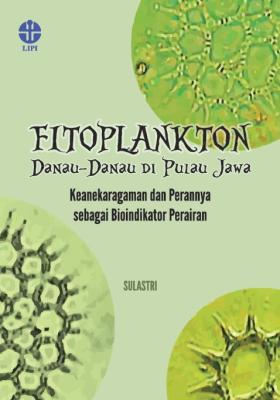Fitoplankton Danau-Danau di Pulau Jawa Keanekaragaman dan Perannya sebagai Bioindikator Perairan
Keywords:
Fitoplankton, Pulau Jawa, DanauSynopsis
Sebagai negara kepulauan, tak ayal jika laut dan pesisir menjadi kekuatan utama Indonesia, yang mengandung sumber daya berlimpah. Namun, orang sering melupakan potensi perairan darat kita, yang sejatinya tak kalah penting dibandingkan lautan. Di Pulau Jawa, danau adalah salah satu sumber primer mata pencaharian masyarakat, selain juga sebagai penyedia sumber daya alam dan penghasil energi. Kerusakan ekosistem danau dapat memberikan dampak negatif yang besar bagi masyarakat. Kerusakan tersebut, umumnya, terjadi karena asupan unsur hara yang terlalu besar sehingga dapat menyebabkan blooming fitoplankton. Meledaknya populasi fitoplankton akan mengakibatkan danau mengalami penurunan kecerahan perairan, peningkatan konsumsi oksigen, dan penurunan kualitas air secara umum. Buku ini hadir dalam rangka memberikan solusi untuk situasi tersebut, melalui pemanfaatan fitoplankton sebagai bioindikator. Buku ini menyajikan informasi lebih dari 50 jenis fitoplankton, yang dapat membantu ahli lingkungan dan dinas terkait dalam mendeteksi kerusakan pada danau sehingga langkah yang tepat dapat diambil.
Downloads
References
Angermeier, P. L., & Karr, J. R. (1994). Biological integrity versus biological diversity as policy directives. BioScience, 44, 690–697.
APHA. (1998). Standard method for the examination of water and waste water, 17th. Edition. Washington D.C.: APHA.
APHA. (2012). Standard method for the examination of water and waste water, 22th Edition. Washington D.C.: APHA.
Bappeda Jawa Barat. Badan Perencanaan Pembangunan Daerah Provinsi Daerah Tingkat I Jawa Barat. (1986). Inventarisasi Data Situ-situ di Wilayah Botabek, 94. Bandung.
Badan Pusat Statistik Provinsi Jawa Tengah. (2016). Provinsi Jawa Tengah Dalam Angka. Semarang: BPS Jawa Tengah.
Badan Pusat Statistik Provinsi Jawa Timur. (2017). Provinsi Jawa Timur Dalam Angka. Surabaya: BPS Jawa Timur
Badan Pusat Statistik Provinsi Jawa Barat. (2017). Provinsi Jawa Barat Dalam Angka. Bandung: BPS Jawa Barat
Bellinger, E. G., & Sigee, D. C. (2010). Freshwater algae: Identi cation and use as bioindicator. New Jersey: Wiley-Blackwell.
Baker & Fabro. (1999). A Guide to the identi cation of common Blue-green Algae (Cyanoprokaryotes) in Australia. Albury, N.S.W: Cooperative R.C. for Freshwater Ecology.
Bartram, J., & Ballance, R. (1996). Water quality monitoring. London: UNEP, E & FN Spon.
Carlson. (1977). A trophic state index for lakes. Limnology and Ocea- nography, 22(2), 361–369.
Carlson & Simpson. (1996). A Coordinator’s Guide to Volunteer Lake Monitoring Methods. Wisconsin: North American Lake Management Society.
Carty. (2003). Dino agellata. Dalam John Wehr & Robert Sheath (Eds.), Freshwater algae of North America: Ecology and classi cation, 685–710. California: Academic Press.
Dokulil, M. T., & Teubner, K. (2011). Eutrophication and climate change: Present situation and future scenarios. Dalam Ansari dkk. (Ed.), Eutrophication: Causes, consequence, and control, 1–6. Berlin: Springer Science Business Media B.V.
Elliot & Sorrel. (2002). Lake manager’s handbook, land-water interaction. Wellington, New Zealand: Ministry for Environment.
Gell, P. A., Sonneman, J. A., Reid, M.A., Illman, M.A., & Sincock, A.J. (1999). An illustrated key to common diatom genera from Southern Australia. Canberra: Cooperative Research Centre for Freshwater Ecology Australia.
Gergel, S.E., Turner M.G., & Kratz, Y.K. (1999). Dissolved organic carbon as an indicator of the scale of watershed in uence on lakes and river. Ecological Application, 9, 1377–1390.
Gerrath. (2003). Conjugating green algae. Dalam John Wehr & Robert Sheath (Eds.), Freshwater algae of North America: Ecology and classi- cation, 353–379. California: Academic Press.
Harris, G. P. (1986). Phytoplankton ecology: Structure, function and uctu- ation. New York: Springer.
Heinonen, P. (1980). Quantity and composition of phytoplankton in Finnish inland water. Publication of the Water Research Institute no. 37. Helsinki: National Board of Water.
Ho?tzel, G., & Croome, R. (1999). A phytoplankton methods manual for Australian freshwaters. Land and Water Resources Research and Development Corporation. Paper 22/99.
Hutchinson, G. E. (1967). A treatise on limnology Vol 1. New York: Wiley and Sons, Inc.
Jindal, R., akur, R. K., Singh, U. B., & Ahluwalia, A. S. (2014). Phytoplank- ton dynamics and water quality of Prashar Lake, Himachal Pradesh, India. Sustainability of Water Quality and Ecology, (3–4), 101–113.
John, D. M. (2003). Felamentous and plantlike Green Algae. Dalam John Wehr & Robert Sheath (Eds.), Freshwater algae of North America: Ecology and classi cation, 311–349. California: Academic Press.
Kingston, J. C. (2003). Araphid and Monoraphid diatoms. Dalam John Wehr & Robert Sheath (Eds.), Freshwater algae of North America: Ecology and classi cation, 595–636. California: Academic Press.
Kociolek, S. A., & Spaulding, J. P. (2003). Symmetrical Naviculoid diatoms. Dalam John Wehr & Robert Sheath (Eds.), Freshwater algae of North America: Ecology and classi cation, 637–653. California: Academic Press.
Komara?k, J. (2003). Coccoid and colonial Cyanobacteria. Dalam John Wehr & Robert Sheath (Eds.), Freshwater algae of North America: Ecology and classi cation, 59–110. California: Academic Press.
Komara?k, J., Kling, H., & Koma?rkova?, J. (2003). Felamnteous Cyanobacteria. Dalam John Wehr & Robert Sheath (Eds.), Freshwater algae of North America: Ecology and classi cation, 117–191. California: Academic Press.
Knoll, L. B., Vanni, M. J., & Renwick, W. H. (2003). Phytoplankton primary production and photosynthetic parameters in reservoir along a gradient of watershed land-use. Limnology and Oceanography, 48, 608–617.
Krieger, W. (1933). Die Desmidiaceen der Deutschen Limnologischen Sunda-Expedition. Dalam H.J.Feuerborn, F. Ruttner und A. iene- man: Limnologishen Forchungsreise Java, Sumatra und Bali, 1928 und 1929, Archiv Fu?r Hydrobiologie, Supplement Band XI.
Lowe, R. L. (2003). Keeled and canalled Raphid diatom. Dalam John Wehr & Robert Sheath (Eds.), Freshwater algae of North America: Ecology and classi cation, 669–684. California: Academic Press.
Mankiewicz, J., Tarczynska, M., Walter, Z., Zalewski, M. (2003). Natural toxins from Cyanobacteria. Acta Biologica Cracoviensia Series Botanica, 45(2), 9–20.
Nontji. (1994). e status of limnology in Indonesia. Mitt. Internat. Verein. Limnol., 24, 12–13.
Nygaard, G. (1949). Hydrological studies on some Danish Ponds and lakes: II. e quotient hypothesis and some little known or new phytoplankton organisms. Kunglige Danske Vidensk, 7, 1–242.
Ochocka, A., & Pasztaleniec, A. (2016). Sensitivity of plankton indices to lake trophic conditions. Environmental Monitoring and Assessment, 188, 622. DOI 10.1007/s10661-016-5634-3
Pe?czu?a, W. (2013). Phytoplankton diversity related to habitat heterogeneity of small and shallow humic Lake P?otycze (Eastern Poland). Teka Kom. Ochr. Kszt. S?rod. Przyr. – OL PAN, 10, 291–305.
Padisa?k, J., Borics, G., Grigorszky, I., & Soro?czki-Pinte?r, E. (2006). Use of phytoplankton assemblages for monitoring ecological status of lakes within the water framework directive: e assemblage index. Hydrobiologia, 553, 1–14.
Padisa?k, J., Crossetti, L. O., Naselli-Flores, L. (2009). Use and misuse in the application of the phytoplankton functional classi cation: A critical review with updates. Hydrobiologia, 621, 1–19.
Pasztaleniec, A. (2016). An advanced phytoplankton trophic index: Test and validation with a nationwide lake survey in Poland. International Review of Hydrobiology, 101, 20–35. DOI 10.1002/iroh.201501799.
Prescott, G.W. (1951). Algae of the Western Great Lakes area. Iowa: W. C. Brown Co.
Ryding, S., & Rast, W. (1989). e control of eutrophication of lakes and reservoirs. Man and e Biosphere Series. Vol. 1. Tennesse: Parthenon.
Reynold. (1984). e Ecology of freshwater phytoplankton. London: Cambrid- ge University.
Reynolds, C. S., Huszar, V., Kruk, C., Naselli-Flores, L., & Melo, S. (2002). Towards a functional classi cation of the freshwater phytoplankton. Journal of Plankton Research, 24, 417–428.
Rolland, A., Bird, D. F., Giani, A. (2005). Seasonal change in composition of the cyanobacterial community on the occurrence of hepatotoxic blooms in the Eastern Township, Quibec Canada. Journal of Plankton Research, 27(2), 683 – 694.
Rosowski, J. (2003). Photosynthetic Euglenoids. Dalam John Wehr & Robert Sheath (Eds.), Freshwater algae of North America: Ecology and classi cation, 383–519. California: Academic Press.
Sachlan, M., (1982). Planktonologi. Semarang: Fakultas Peternakan Uni- versitas Diponegoro.
Schwoerbel. (1970). Methods of hydrology: Freshwater biology. Oxford: Pergamon Press.
Scott, A. M., & Prescott, G. W. (1961). Indonesian Desmid. Hydrobiologia, 17(1–2), 1–132.
Stevenson, R. J., & Smol, J. P. (2003). Use of Algae in Environmental Assessments. Dalam John Wehr & Robert Sheath (Eds.), Freshwater algae of North America: Ecology and classi cation, 775 – 804. California: Academic Press.
Shubert. (2003). Non motile coccoid and colonial green algae. Dalam John D. Wehr & Robert G. Sheath (Eds.), Freshwater algae of North America: Ecology and classi cation, 253–416. California: Academic Press.
Sulastri, Harsono, E., Suryono, T., & Ridwansyah, I. (2008). Relationship of Land Use, Water Quality and Phytoplankton Community of Some Small Lakes in West Java, Oseanologi dan Limnologi di Indonesia, 34(2), 307–332.
Sulastri. (2009). Karakteristik Komunitas Fitoplankton dan Faktor Ling- kungan Danau-Danau Kecil di Pulau Jawa. Jurnal Penelitian Perikanan Indonesia, 15(2), v–xviii.
Sulastri, Suryono, T., Sudarso, Y., & Rosidah. (2009). Karakteristik sik kimiawi limnologi danau-danau kecil di Pulau Jawa. Limnotek, 16(1), 10–21.
Sulastri, Suryono, T., Sudarso, Y., & Nomosatriyo, S. (2010). Pengembangan kriteria status ekologis danau-danau kecil di Jawa. Limnotek, 17(1), 58–70.
Sulastri, Takamura, N., & Yuniarti, I. (2012). Phytoplankton of Rawa Pening Lake and Gajah Mungkur Reservoir of Central Java. Dalam Prosiding Seminar Nasional Limnologi VI, 598–610. Cibinong: P2 Limnologi-LIPI.
Sulastri, Sulawesty, F., & Nomosatriyo, S. (2015). Long term monitoring of water quality and phytoplankton changes in Lake Maninjau, West Sumatra, Indonesia. Oseanologi dan Limnologi di Indonesia, 1(3), 23–38.
Sulastri, Henny, C., & Handoko, U. (2016). Environmental condition and trophic status of Lake Rawa Pening in Central Java. Oseanologi dan Limnologi di Indonesia, 1(3), 23–38.
Soeprobowati, T. R., Hadisusanto, S., Gell, P., and Zawadski, A. (2012). e diatom stratigraphy of Rawa Pening Lake, implying eutrophication history. American Journal of Environmental Sciences, 8(3), 334–344.
unmark. (1945). Zur Soziologgie des susswasessplankton: Eine metho- dologissch-okologische Studie. Folia Limnologica Scandinavia, 3, 1–66.
Uchida. (1997). e study on the characteristic of island water body in Indonesia: Investigation for realitical technology of trophical area. Cibinong: P2 Limonologi LIPI dan Japan International Cooperation Agency.
Vollenweider. (1969). A manual on methods for measuring primary pro- duction in aquatic environments. IBP Handbook No. 12, International Biological Programme. Oxford: Blackwell Scienti c Publications.
Vollenweider. (1968). Scienti c fundamental of the eutrophication of lakes and owing waters, with particular reference to nitrogen and phosphorus as a factor in eutrophication. OECD Rep.DAS/CSC/68.27. Paris: Organisation for Co-operation dan Development.
Van Vuuren, S.J., Taylor, J., van Ginkel, C., & Gerber, A. (2006). Easy identi cation for the most common of freshwater algae: A guide for identi cation of algae in South African freshwater. PotchefstrooNorth- West Universitym: North-West University.
Wetzel, R. G. (2001). Limnology: Lake and river ecosystem. New York, London: Academic Press.
Wehr, J.D., & Sheath, R.G. (Eds.) (2003). Freshwater algae of North America: Ecology and dassi cation. California: Academic Press.

Downloads
Published
Series
License

This work is licensed under a Creative Commons Attribution-NonCommercial-ShareAlike 4.0 International License.






























